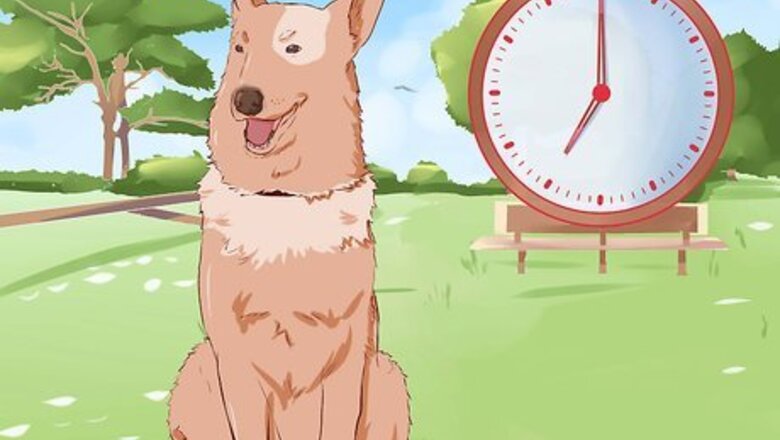
views
Building a Routine for Your Dog
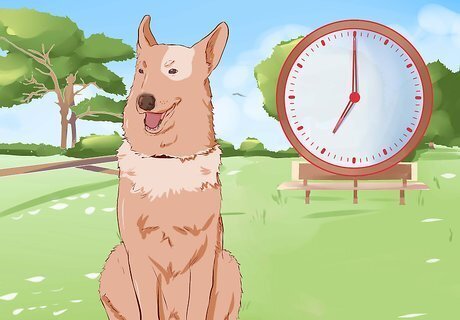
Keep your dog on a bathroom schedule. Having a daily routine is important for dogs of any age, but it's especially important for younger dogs. A puppy can typically only hold his bladder for one hour per every month of age, meaning that young puppies may need to go outside once every hour. It's best to establish a routine as quickly as possible with your dog to ensure that he doesn't have any problems. In addition to the correlation between number of months of age and number of hours a puppy can wait to go out, it's also important to let your dog out first thing in the morning, during or after play time, and after he's eaten a meal or drank a lot of water. This time also refers to the maximum length of time he can hold on (i.e. at night). When house breaking a puppy, it is important to offer him a toilet break every 20–30 minutes for training purposes.
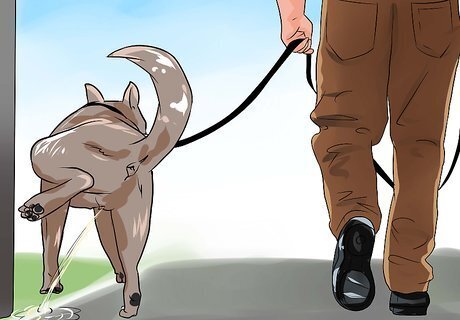
Let your dog have a designated bathroom spot. Whether you walk your dog or let him outside in a fenced-in enclosure, it's important for your dog to have a routine spot where he urinates. This can be a tree that you pass near your home, or a certain spot in the yard. Whatever spot your dog chooses, it's important to let him always have access to that spot while you are training him to urinate outdoors.
Rewarding Good Behavior
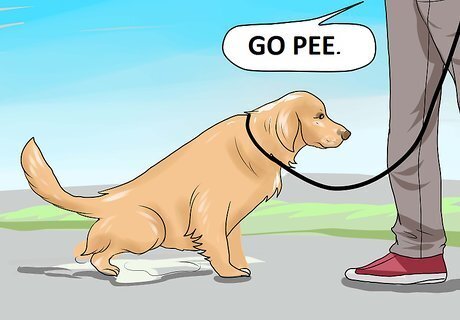
Use a verbal command on walks. Try associating a verbal command with your dog's chosen bathroom spot, or with any spot that you pass immediately after leaving the house. You can say something like, "Go potty," or "Go pee" every time he urinates in that spot. Over time, your dog will hear that command and recall the associated act of urinating.
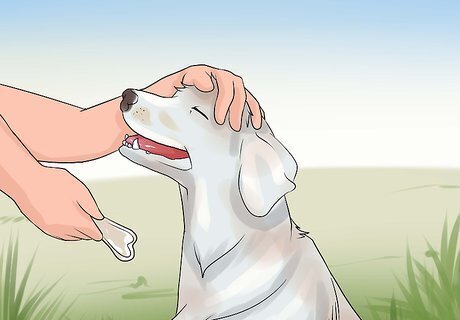
Praise your dog. Whenever your dog follows your command of "go potty" when you let him outside, immediately praise him and give him a treat within three seconds of the positive behavior. It's important to follow rewards or praise immediately after positive behavior, as dogs have a hard time associating actions and praise if too much time has passed.
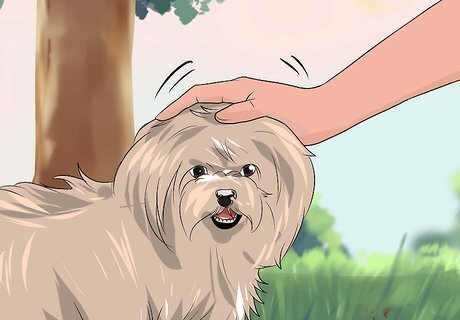
Gradually reduce food treats. As your dog's training continues, you may want to slowly reduce the frequency of food treats after he relieves himself, eventually phasing them out altogether. Treats are an important and helpful part of training early on, but rewarding your dog with food every time he relieves himself should not become a lifelong habit.
Incorporating Crate Training
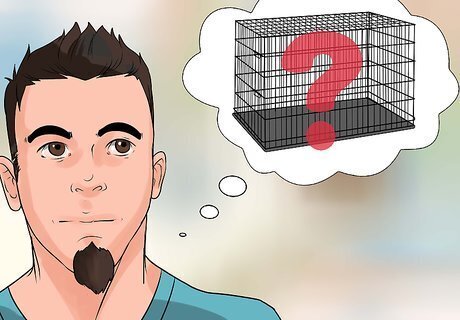
Choose the right crate. Crate training is a great method to incorporate when trying to housebreak your dog. Dogs come to view the crate as a sort of den within your home, and no dog wants to voluntarily soil the den. However, crates are not a simple fix. Crate training takes time and patience, and you'll need to make sure your dog is comfortable in his crate. Crates come in a variety of materials and versions. There are plastic crates that are typically used for traveling, and there are metal crates with folding/collapsing frames. Choose a type of crate that will be most conducive to your needs, and be sure it's something your dog will not be able to chew or destroy easily, if that is a concern with your pet. Choose the right size. A crate should ideally be just large enough for an adult dog to stand upright, turn around in it, and lie down with his legs extended. If a crate is too big, your dog may designate one corner of the crate as a bathroom spot. If it's too small, your dog will be cramped and uncomfortable. If your dog is young and you expect that he will continue to grow, talk to your veterinarian about how to measure a crate that will fit your dog's anticipated adult body size.
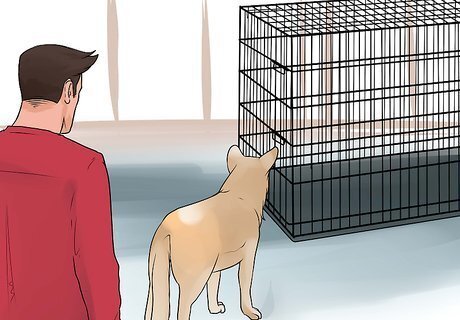
Introduce your dog to his crate slowly. If you try to toss your dog into a crate without any proper introductions, he may become traumatized and fearful of the crate. It's best to introduce a new crate slowly, by encouraging your dog to explore the crate and using gentle, reassuring tones whenever he approaches it. Try leaving the door to the crate open and periodically dropping treats in the crate. Start by leaving treats near the door, and progressively drop the treats further inside the crate. Let your dog explore the crate whenever he wants. Leave the door open so that he feels like he can go inside at his leisure.
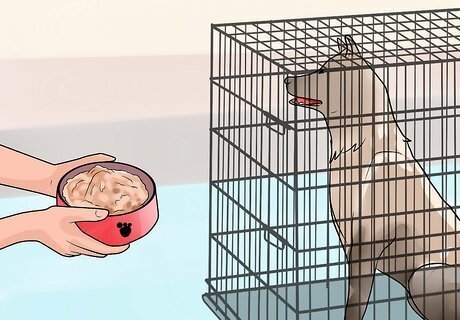
Begin giving your dog his meals in the crate. Once your dog is comfortable and acclimated to venturing inside his new crate, you'll want to begin feeding him his meals inside the crate. This will help him get accustomed to going into the crate as a part of daily life. Close the door of the crate while your dog is eating. When you first begin doing this, you'll want to open the crate as soon as your dog finishes his meal, so he doesn't become frightened. You can gradually increase the amount of time you leave the door closed, adding a minute or two every couple of days. If your dog begins to whine, cry, or bark, do not let him out right away. Wait until he stops acting out before opening the crate. If you open the door whenever he barks, he will begin to think that barking gets him out whenever he wants. Once your dog is comfortable staying in the crate for close to a half hour without incident, it is safe to start leaving your dog in the crate when you leave the house for brief errands, and you may want to consider leaving him in the crate overnight. Expect this process to take up to several weeks before your dog is comfortable being left alone in the crate.
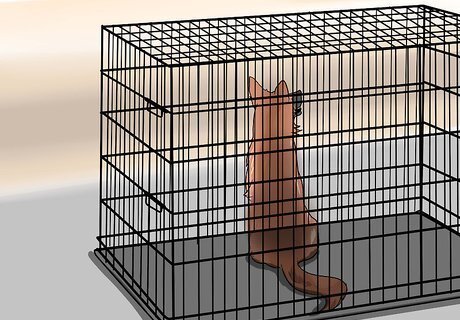
Start crating your dog regularly. After your dog has proven capable of being left alone for brief periods of time, you can begin leaving him in the crate when you leave the house. It's best to prolong putting your dog inside the crate until you are almost ready to leave; otherwise he may get anxious and fail to understand why he's locked inside while you're still home. Be sure to let your dog outside to relieve himself right before you put him in the crate. Failing to give your dog adequate outdoor time before being crated could increase the likelihood of his having accidents when you're not home. Never use the crate as punishment. You do not want your dog to associate the crate with being yelled at or punished. As long as you continue to feed him in his crate and only use the crate for training purposes (such as preventing him from destroying the house while you're not home), he should have only positive associations with the crate.
Dealing with Accidents
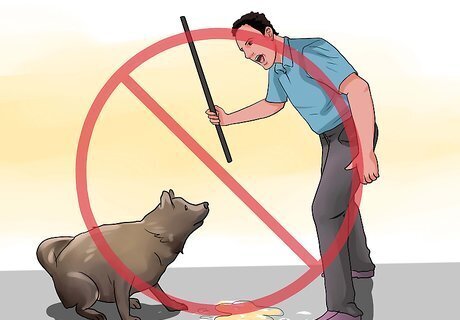
Do not punish your dog for accidents. Your dog will inevitably have occasional accidents, even after successfully house training him. Accidents may happen frequently during the training process. It's important to remember that your dog did not mean to have an accident, and that he will eventually learn not to make it a habit. Do NOT yell at your dog or rub his face in the mess when he has an accident. This does not help your dog learn from his mistakes, and it may cause him to become fearful of you. Take accidents in stride and be patient with your pet.
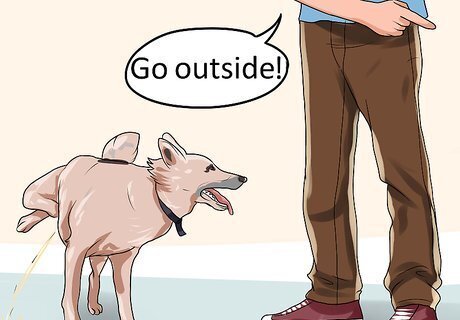
Interrupt indoor accidents when you observe them. Any time you observe your dog urinating in the house, make a startling noise, like clapping your hands or saying "Go outside". Then take your dog outside and praise him if he finishes relieving himself outdoors.

Clean up accidents thoroughly. Dogs have a keen sense of smell, and may come to associate a former accident spot as an acceptable bathroom location if the smell is not properly cleaned away. This can be especially problematic in younger puppies. Use an enzymatic cleaner to thoroughly remove odors after accidents indoors. If you have a yard, you can use indoor accidents as a training tool. Any time you clean up an indoor accident, take the urine-soaked paper towels outside to the dog's usual bathroom area. Leave the paper towels outside on the ground, using a rock or stick to secure them in place. Once your dog smells his urine on the paper towels, he will firmly associate going to the bathroom with being outside. As soon as your dog learns the lesson and begins relieving himself outside again, you can remove the soiled paper towels.
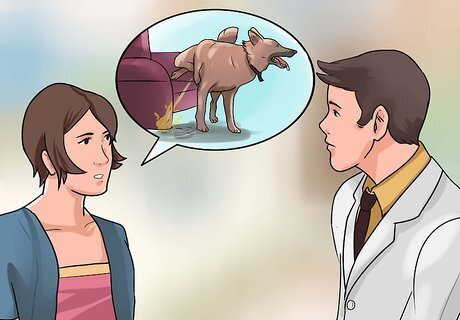
Recognize potential problems. If your dog is having a hard time refraining from relieving himself indoors, it's possible that he's suffering from a medical ailment or emotional problem. Consult your veterinarian to determine whether your dog has any of the following problems: urinary tract infection (UTI) surface preferences (desire to eliminate waste only on certain types of surfaces or textures) anxiety/fear of going outdoors separation anxiety urine marking of household objects submissive or excitement urination















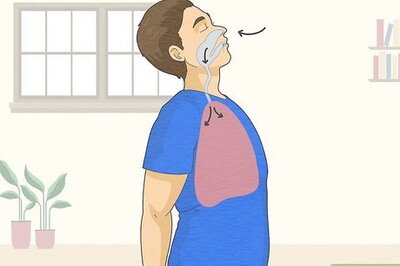

Comments
0 comment